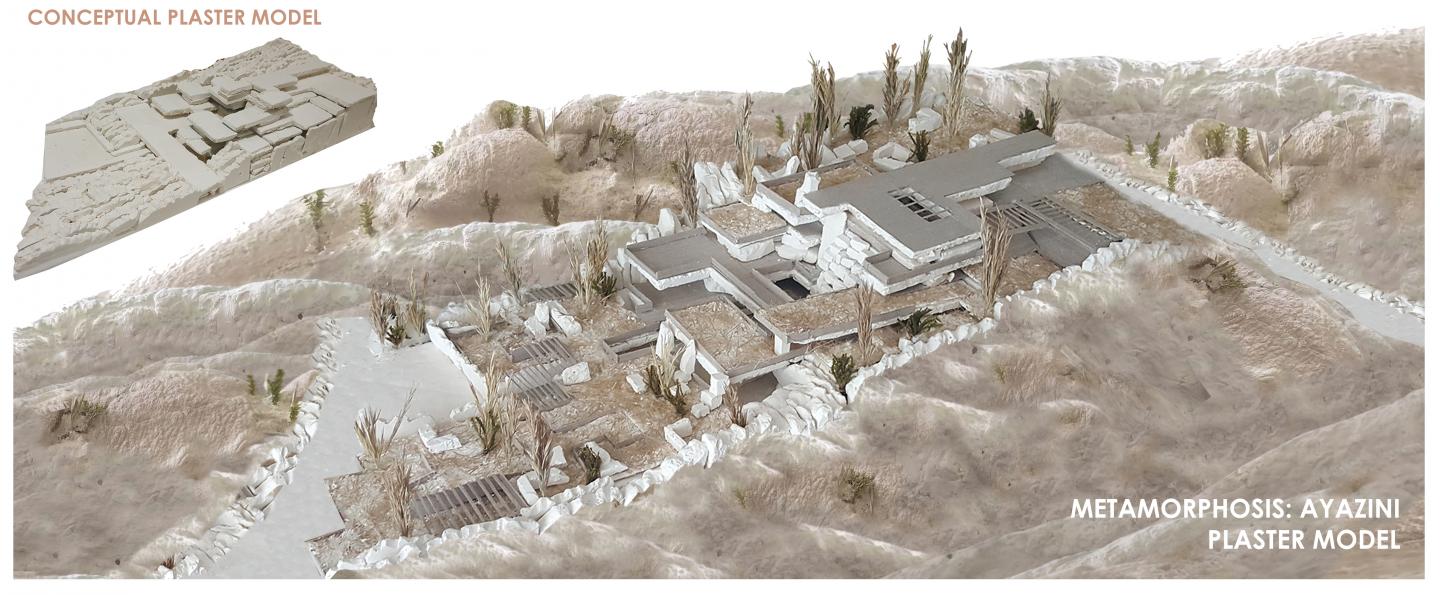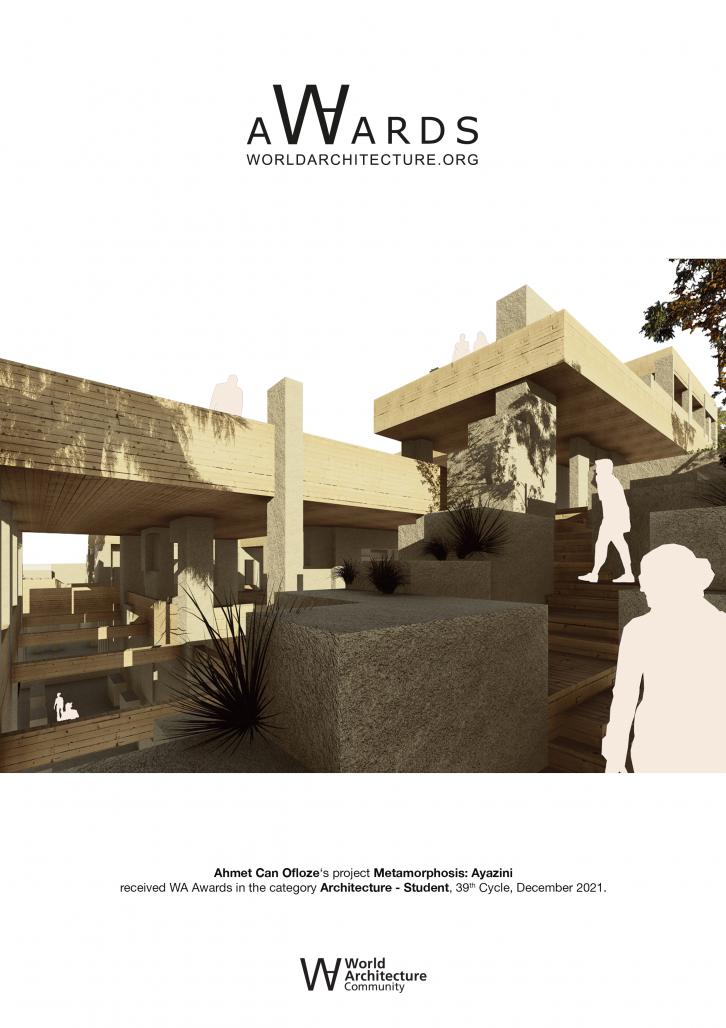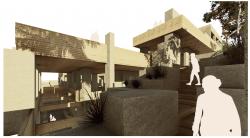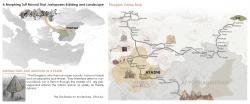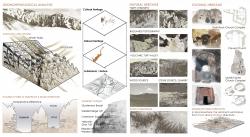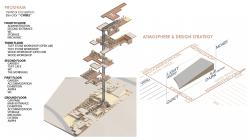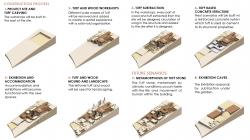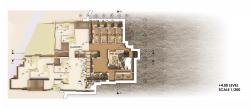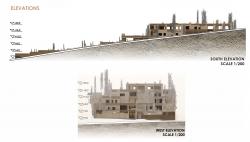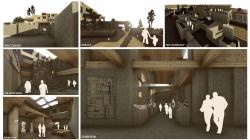Metamorphosis Ayazini is an architectural proposal that is located in Ayazini village, Afyonkarahisar, Turkey and conceptualized as an ever-evolving Mound. Here, nature, topography, landscape and building intertwine, primarily as a result of the geologically unique tuff stone formations and the affordance of tuff stone as architectural inspiration. Metamorphosis Ayazini highlights tuff in a holistic and site-specific manner, and infuses it into every aspect of the project - into its unique concept, program, spaces, building language, materials and technology.
Tuff rock is a particular rock that is formed as a result of petrification over millions of years under high temperature and pressure. Then, molten rock reaches the Earth's surface through volcanic activity and cools off, creating the rock substratum. But the shaping of the landscape does not stop there in Ayazini; indeed the foundations to an ever-continuing process is just laid. The landscape is continually sculpted both by the climate and ongoing human life.
Climatic and natural factors that affect tuff formation include - amongst many - seasonal and daily temperature differences, wind currents, water courses, rainfall, storms, and floods. These factors affect, erode and shape the tuff rock itself and generate distinctive geomorphological forms. At the same time, the rock substratum in Ayazini is mixed primarily with alluvial soil. Particularly water courses move the alluvial soil from hills to stream beds and expose further the tuff rock along their path. This contributes to the landscape characteristics.
The project’s concept was informed through rigorous analyses of natural and cultural heritage values of Ayazini. Amongst these values, tuff and wood stand out as materials components of heritage values. Inspired by this finding, an associated original rural development plan is proposed. Our user analyses revealed that many young residents have left Ayazini to find employment elsewhere. Stone and wood carving workshops proposed in the program contribute to local production and preservation, while creating new opportunities and job sectors for the residents. Workshops keep local traditions of making, crafts, and building alive. Exhibition spaces are attached to workshops with the aim of permanent and temporary exhibits that showcase local construction techniques. This know-how would be documented not only on paper, but also real samples maintained at various scales, from past to present in Ayazini. Rural development is interwoven with documenting local heritage, preserving it and transferring it to future generations.
The Mound traces impressions of the past and the village vernacular. It enlivens lost values and preserves existing ones in the village. At the same time, the structure governs tuff erosion parameters, such as climatic conditions and the patterns of ongoing life on the site. It raises awareness by putting on display the dynamic morphology of its architectural forms, by acting almost as a monument where nature and humans shape the tuff together.
The construction process of the project is designed in phases. In the first phase, workshops are built to the east of the site. Tuff stones of different masses for the production of crafts are continually removed and added to the structure to create a spatial experience with solid-void organizations. In the workshops, extracted tuff stone, along with wood, are circulated during use in the structure and added to the site after their design and construction is completed. The second phase is built with a reinforced concrete system in which tuff is used as cement due to its structural properties. Accommodation and exhibitions become functional as new scenarios, new spaces are created. Leftover tuff and wood are used in landscape design. The future scenario of the Mound presupposes the expansion of the exhibition by continuing the extraction under the garden to the West, and new spaces are introduced as new needs arise.
A radial space-atmopshere sequence organizes the project. Considering wind, sun and accessibility patterns, exhibits orientate to the West; for the full, dramatic experience of tuff-carving, accommodation to the North. Atmospheric thresholds accompany spatial ones and are achieved by differing light, sound, wood smell, tuff texture. The large stack of tuff blocks at the center of the Mound, surrounding the main staircase, act as a monumental architectural element. The blocks are stored unprotected against climatic conditions, therefore they also change shape in time as they erode when exposed to the elements and human use. In addition to the staircase, the elevator next to the tuff monument is located at the spine of the structure. This allows users to experience the structure at different levels, bearing witness to the process of metamorphosis and morphing of the site.
2021
Project Site: 6255 m²
Tuff stone can be easily excavated and turned into a shelter. It provides optimum humidity and temperature throughout the year. Its structural characteristics have kept tuff in use throughout history.
‘’The Phrygians, who live in an open country, have no forests and consequently lack timber. They therefore select a natural hillock, run a trench through the middle of it, dig passages, and extend the interior space as widely as the site admins.’’ - Vitruvius (Ten Books on Architecture)
Designer:
Ahmet Can OFLOZER
Supervisors:
Aslı ARPAK, Ph.D.
Nil Nadire GELİŞKAN, M.Sc.
Metamorphosis: Ayazini by Ahmet Can Oflozer in Turkey won the WA Award Cycle 39. Please find below the WA Award poster for this project.
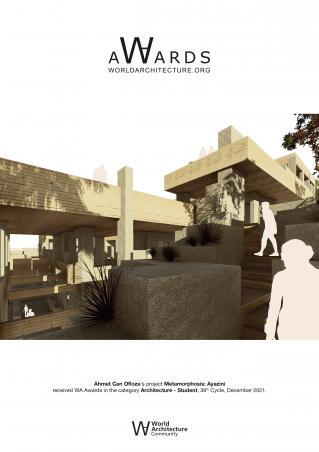
Downloaded 0 times.
Favorited 8 times
